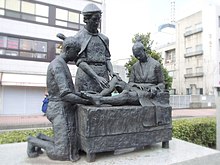Luís de Almeida
Luís de Almeida (* around 1525 in Lisbon ; † October 1597 in Kawachiura , Japan) was a Portuguese surgeon, merchant and then a missionary of the Society of Jesus in Japan.
Life
Luís de Almeida was born in Lisbon around 1525 to a family who had converted from Judaism to Christianity. After a two-year training at the renowned Hospital Real de Todos os Santos (Royal All Saints Hospital), he received the surgical license from the Portuguese king in March 1546. He then moved to Goa and from there to Macau and engaged in intra-Asian trade with some success. These activities brought him to Japan for the first time in 1552, where with the landing of the Jesuit Francisco de Xavier the age of direct and lasting Euro-Japanese contacts had begun. The country also attracted Portuguese merchants, who found a great demand for raw silk, silk fabrics, cotton goods, Chinese medicines and other goods that Japan could not produce in sufficient quantities. In Yamaguchi he met the Jesuit Father Cosme de Torres , who headed the mission after Xavier's departure, and was deeply moved by the commitment of the Christian mission.
In 1555, on the occasion of his second visit to Japan, he joined the Society of Jesus and was now looking for ways to use his accumulated financial means wisely. After the Fourth Lateran Council of 1215, clerics were prohibited from performing surgical activities that inevitably caused blood to flow ("ecclesia abhorret a sanguine"). As a non-ordained lay brother, however, de Almeida was exempt from this. In the year he joined, he founded an orphanage in Funai (today heuteita ) in the east of the island of Kyushu , because many children had lost their parents as a result of the violent hegemonic struggles of the Japanese regional rulers.
In 1556 he built a hospital in Funai with the permission of the baptized prince ( daimyō ) Ōtomo Sōrin ( 大 友 宗麟 , "Dom Francisco de Bungo "). These construction costs (approx. 5000 cruzados ) were also covered from his assets. As far as the letters (port. Cartas ) sent to Goa and Europe indicate this, this hospital was able to accept around 100 patients. De Almeida initially headed the surgical department himself; internal medicine was in the hands of converted Japanese monk doctors, who applied Sino-Japanese therapies there so successfully that some of them were praised by name. In addition, one took care of the leprosy , who were exposed to severe social discrimination. Today, the first 'western' hospital in Japan built by de Almeida is considered a historic pioneering achievement. But at that time the enthusiasm within the Society of Jesus was limited. Since the hospital offered a good opportunity for proselytizing (“medicine for the body, prayers for the soul”), it was more or less tolerated, although the missionaries were forbidden from doing medical work there.
De Almeida also had to open up a new field of work after 1560. He spent the year 1561 with missionary activities in Hakata (now part of the city of Fukuoka ), Hirado and Kagoshima . In 1562 he obtained a landing permit for Portuguese ships in Yokoseura (today incorporated into the city of Saikai ). The following year he founded churches in Shimabara and Kuchinotsu (now part of Minamishimabara ). In 1564 he spent in the Kansai region and in 1567 in Nagasaki . The hospital he built in Funai was destroyed in 1587 by troops from Satsuma .
After many years of tireless service in the Japanese mission, de Almeida was ordained a priest in Macau in 1580 , but died three years later in Kawachiura (now part of Amakusa (Kumamoto) ).
literature
- John Z [Immermann] Bowers: Western medical pioneers in feudal Japan . Baltimore [u. a.]: Johns Hopkins Press, 1970.
- Dorotheus Schilling: The school system of the Jesuits in Japan (1551-1614) . Munster 1931.
- Dorotheus Schilling: Os Portugueses ea introdução da medicina no Japão. Coimbra 1937.
- Wolfgang Michel: On the Reception of Western Medicine in Seventeenth Century Japan . In: Yoshida Tadashi / Fukase Yasuaki (ed.), Higashi to nishi no iryôbunka (Medicine and Culture in East and West). Kyôto: Shibunkaku Publisher, 2001.
- Wolfgang Michel: Early Western Observations on Acupuncture and Moxibustion . In: Sudhoffs Archiv, Volume 77, No. 2 (1993), pp. 194-222.
- Diego R. Yuuki: Luís de Almeida (1525-1583) - médico, caminhante, apóstolo . Macau: Instituto Cultural de Macau, 1989.
swell
- Cartas que os Padres e Irmãos da Companhia de Jesus escreverão dos Reynos de Iapão & China. Evora: Manoel de Lyra, 1598.
- Luis Frois: The History of Japan (1549-1578). Translated from the manuscript of the Ajuda library in Lisbon and commented on by G [eorg] Schurhammer et al. E [rnst] A [rtur] Voretzsch. Leipzig: Asia Major, 1927.
Remarks
- ↑ Bowers, 1970, p. 12.
- ↑ Schilling (1931). Michel (1993)
- ↑ Schilling (1931)
- ↑ Cartas (1598), Livro I, fol. 64
- ↑ Cartas (1598), Livro I, fol. 56, 62v, 64, 77; Frois, p. 63.
| personal data | |
|---|---|
| SURNAME | Almeida, Luís de |
| BRIEF DESCRIPTION | Portuguese missionary of the Society of Jesus |
| DATE OF BIRTH | around 1525 |
| PLACE OF BIRTH | Lisbon , Portugal |
| DATE OF DEATH | 1583 |
| Place of death | Kawachiura, Japan |
